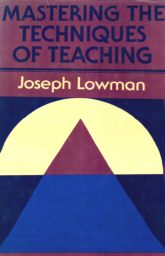"Why has the lecture survived?" Lowman asks pointedly about the survival of the live
lecture format on page 96 after evoking images of students struggling to stay awake in soporific
lectures. Considering only the pedagogical aspects of this, it is my belief that the lecturer's
understanding is transmitted directly to the brain of the student when both minds are tuned to the
same wavelength — the tuning occurs during listening when both the lecturer and the student are
thinking the same thoughts. In any teaching and learning situation using a written or otherwise
pre-recorded media, the student must do the job of both the absent professor and the student, i.e.,
must perform both as the transmitter and the receiver. That is an enormously more difficult job,
one whose magnitude of difficulty is glossed over or simply ignored by educational firms selling
and promoting such recorded lessons.
[page 101] While many theorists stress the importance of events outside
individuals for learning, the position taken here is that human learning is
heavily mediated by internal events — thoughts or cognitions.
And it is the thoughts and cognitions in both the teacher and the learners that must
become intermeshed in a seamless web of instantaneous rapport for that understanding to be
communicated effectively. To me it is obvious that the live lecture is the most powerful tool for
accomplishing such a transfer of understanding. Thus, I would heartily agree with Lowman's
point on page 110, "A completed set of notes is no substitute for having been in class to make
them."
In Lowman's chapter on developing style, he gives many useful techniques for teachers
beset by a barrage of questions from their charges. Here's two sample techniques that illustrate
the valuable insights that the author provides again and again throughout this book.
[page 56] Q: "But how are we supposed to know which of these names is
important?"
A: "That's a good question. I guess some of the people mentioned in the book
have had more impact on the field than others and are more important, but I
hope everyone appreciates that they are all notable authors (scientist, artists,
philosophers, or whatever). I would rather that you decide how they are
similar and different and what impact they have had on each other than try
to guess how I might decide to rank-order them."
[page 60, Question from a sniper about the racist, sexist, or elitist attitudes of
some historical figure. ] A: "That's an interesting point, and it raises an
important dilemma for the historian: How can we look at distant events
through the eyes of the people of that era, rather than coloring them with
contemporary values? We will discuss historical methods again in a few
weeks. For now, let me say that I very much sympathize with your concerns
and I suggest that all of us try to imagine why this leader did what he did
given the way that he and many others of his time viewed the world."
Lowman is a master teacher and is constantly on the watch for ways to improve his own
teaching. He exhorts us to examine our own teaching processes as he teaches us about warming
up before a class. On page 91 he tells a story about his psychology class that was moved across
campus during a semester and required a ten minutes' walk to reach the class. Rather than the
usual thirty seconds jaunt to the class, he had ten minutes of walking between class. He noticed
that he could begin teaching immediately with the energy and concentration that usually took him
ten minutes into the class to reach. He writes, "In effect, I had been warming up at the students'
expense in the past."
[page 92] When I mentioned this to one of my students, a drama major, she
said that no actor or musical performer would ever fail to prepare
emotionally before going on stage, and she wondered where I had gotten the
idea that college teachers were exempt from this rule!
In his chapter on classroom discussions, he gives us a simple way of implementing the
"believing-doubting game" originated by Peter Elbow
[See ARJ: Embracing Contraries ].
[page 126] One popular form of role playing is a "minidebate" between
students: Those sitting in one half of the room argue for one position, and the
reset assume the opposing view. If a show of hands indicates an equal split on
an issue initially, one variation is have each side assemble and argue for the
position they do not endorse, against their own beliefs. This is guaranteed to
produce a lively exchange and a fresh consideration of the topic by all.
In closing the book, Lowman finishes with this insightful passage in which he refers to
the extensive interviews he did with masterful teachers over the years.
[page 227] My interviews convinced me that ultimately every great teacher
decided to work at mastering this art for the very personal reason that being
a virtuoso in the classroom is so inherently rewarding.
~^~
Any questions about this review, Contact: Bobby Matherne
~~~~~~~~~~~~~~~~~~~~~~~~~~~~~~~~~~~~~~~~~~~~~~~~~~~~~~~~~~






